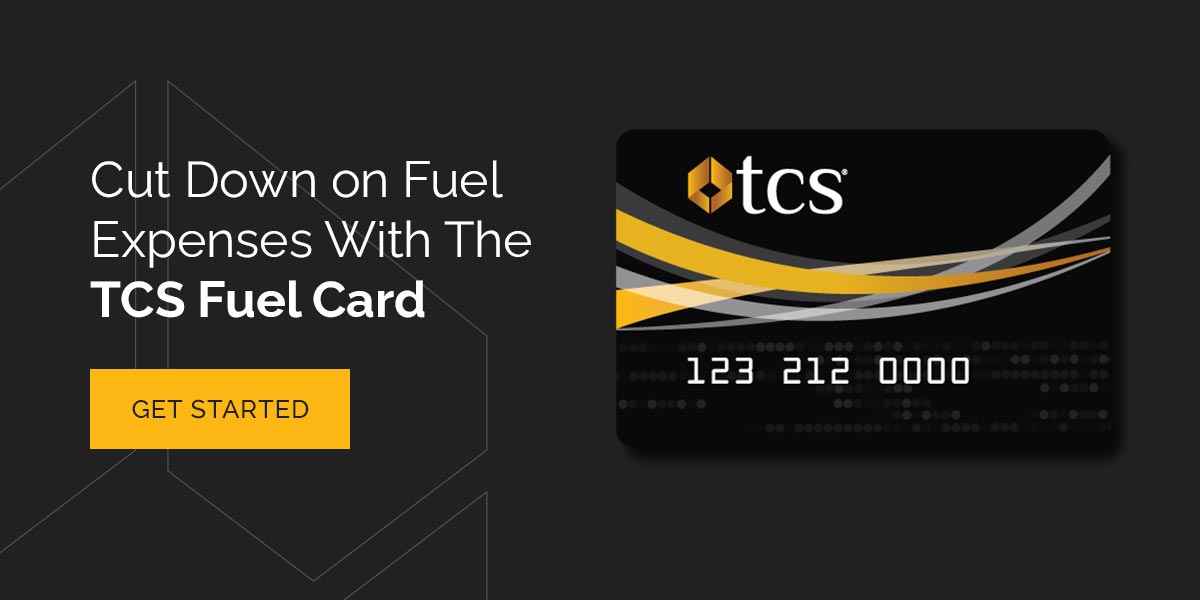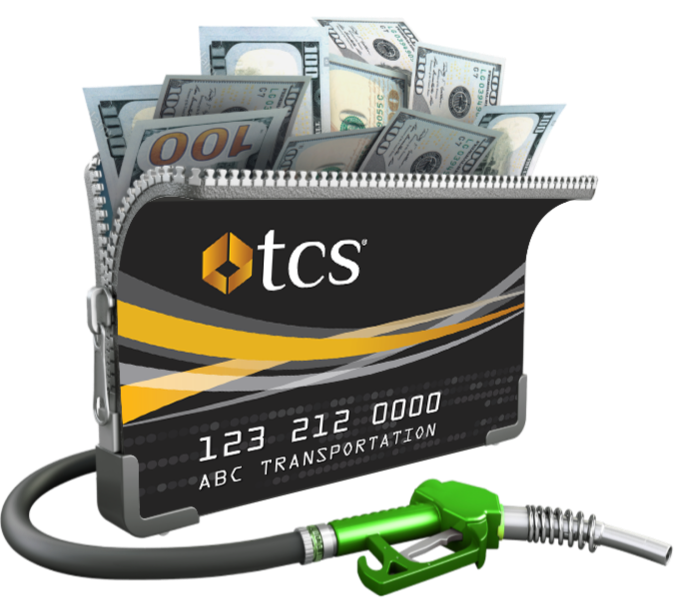

With today’s unsteady fuel prices, filling up at the pump can seem pretty scary for your trucking company’s fuel budget. Using fuel is unavoidable — your small business and drivers’ livelihoods depend on driving trucks from point A to point B, so as a business owner, you’re probably looking to save money on fuel.
12 Ways to Save Fuel as a Small Trucking Company
We’ve come up with a few cost-efficient tips to help you lower your annual fuel costs because you deserve to save money! These tips are easy to implement into your fleet’s routines, so you can get right to saving money as a small trucking company.
1. Reduce Drag
The aerodynamics of your fleet’s semi-trucks and tractor-trailers can affect how much fuel your vehicles are consuming during trips. Less aerodynamic trucks create drag when driving, meaning your truck is fighting against wind resistance. More drag or wind resistance forces your vehicle to work harder to maintain speed, causing it to use more fuel than normal.
You can reduce drag and improve fuel efficiency by installing aerodynamic improvement devices on your fleet’s trucks, which allow your vehicles to cut through tough wind resistance:
- Side skirts: Side skirts decrease the amount of air flowing under your trailer while driving, improving airflow, and reducing drag.
- Boat tails: These panels can be added to the back of your trailer to prevent turbulence that pulls your vehicle backward.
- Gap reducers: Gaps between your truck and trailer can disrupt airflow around the vehicle, increasing drag. Gap reducers cover your truck’s gap and decrease air resistance.
- Mud flaps with vents: Wheel flaps protect your undercarriage and vehicles behind you from getting hit by flying debris like rocks and dirt. Vented mud flaps provide that same protection while also letting air pass through.
- Wheel covers: Wheel covers protect against disruptive airflow as your tires spin, reducing air resistance.
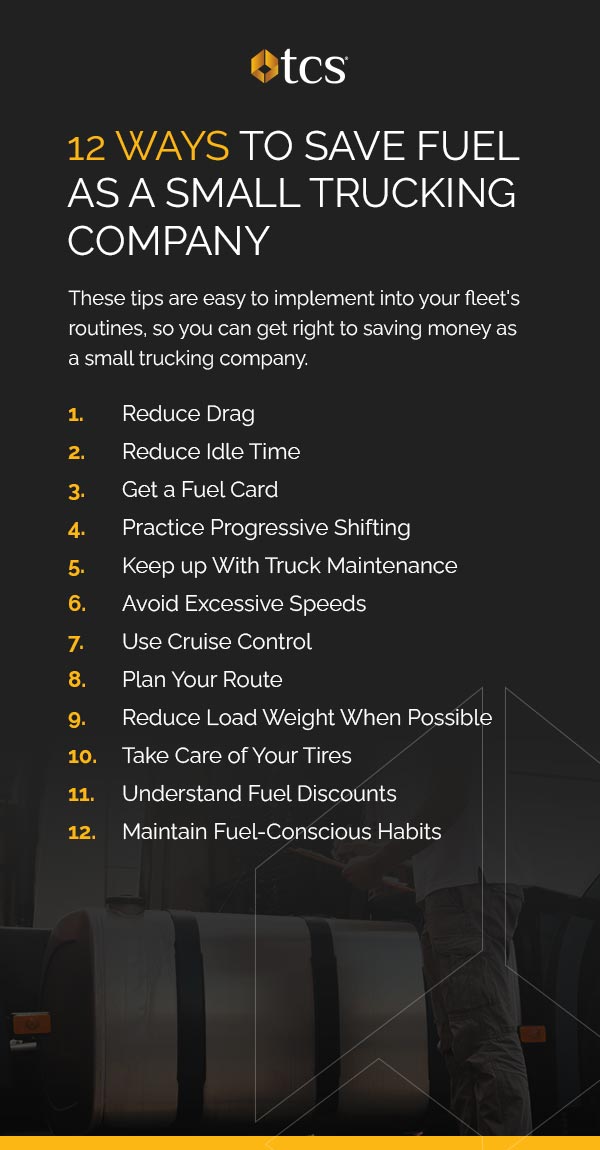
2. Reduce Idle Time
While it seems harmless, unnecessary idling can wreak havoc on your fleet’s engines in the long run. Idling creates excess heat that can either cause your truck to overheat or wear out engine parts more quickly. And, of course, you’re using up valuable fuel.
According to a Colorado government campaign aimed at reducing vehicle idling, trucks can idle up to eight hours a day, totaling up to $12,000 in fuel per truck each year. Additionally, idling can increase truck maintenance costs and the frequency of your fleet’s visits to the repair shop due to wear and tear.
These are just a few easy ways you can reduce your fleet’s idle time to save money on fuel:
- Have your drivers turn off their engines when talking to customers
- Encourage your drivers to turn off their trucks’ engines when taking breaks, if possible
- Incentivize reducing idle time
Remember that states have different regulations regarding idle time, too. Most places allow idling for a maximum of three to five minutes. In some areas, idling is off-limits entirely. Fines for disregarding anti-idling laws can reach up to $25,000. With fuel prices fluctuating, you don’t want to add a hefty fine to your fleet either. Ensure your drivers understand the anti-idling laws where they’re traveling so you can save on fuel costs and avoid potential fines.
3. Get a Fuel Card
Fuel cards save money on fuel and offer security controls. While regular gas credit cards can be used to purchase diesel, fuel cards offer the benefit of saving money per gallon of diesel. And who doesn’t want to save money on fuel these days?
The most significant benefit of using fuel cards versus regular gas cards is the savings. When you refuel at truck stops partnered with the card provider, you can get diesel savings. Another major plus of fuel cards is their ease of use. They work like loyalty or debit cards, so your drivers don’t have to worry about learning how to use them. Plus, they no longer have to worry about carrying around wads of cash for fuel.
With fuel cards, you’ll have added security and control. You control what the cards can be used for, how much drivers can buy, and where they can use the cards.
You’ll get transparency with your fuel card, too. View every transaction associated with the card so you can see how much your drivers are spending at the pump. These security and transparency elements help reduce fraud risk and resolve unauthorized purchases quickly. You’ll save money with fuel cards, and you’re saving yourself plenty of headaches.
4. Practice Progressive Shifting
When your fleet is traveling hundreds of miles a day, progressive shifting can make all the difference in better fuel efficiency and engine longevity. Progressive shifting can reduce your fleet’s fuel consumption and wear on transmissions. Progressive shifting gets your truck moving at the lowest possible revolutions per minute (RPM) in each gear. A higher RPM puts more stress on your truck’s engine, increasing fuel use, and hurting your vehicle’s fuel efficiency.
When accelerating, drivers should change gears upward as quickly as possible. Diesel engines produce the most torque at lower RPM ranges, so there’s quicker acceleration when progressive shifting is done correctly. After drivers complete each shift correctly, the truck’s engine and transmission should operate at or near the lowest RPM speeds.
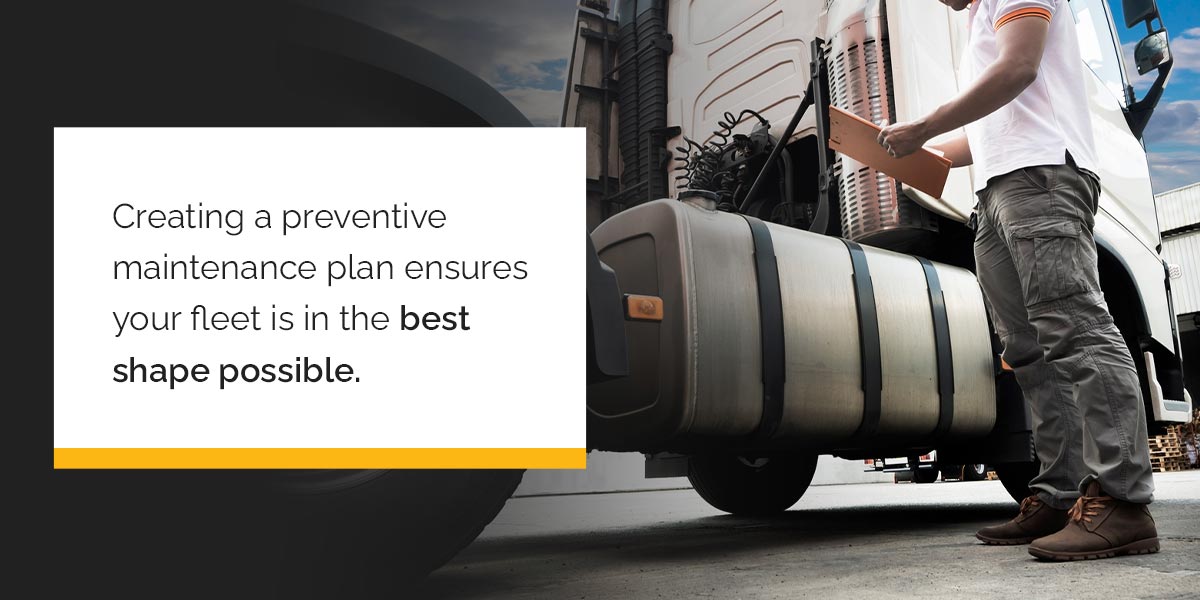
5. Keep up With Truck Maintenance
Creating a preventive maintenance plan ensures your fleet is in the best shape possible. Your preventive maintenance plan should include regular checkups, inspections, and any necessary repairs. This way, you’re catching potential issues before they damage your truck, not after. What may seem like a minor problem that doesn’t need to be fixed right away could turn into a problem that results in costly repairs.
Check these systems to ensure they don’t cause significant problems down the road:
- Inspect engine fan
- Ensure battery cables are secure
- Inspect brakes
- Check fluid levels
- Check tire pressure
- Monitor your truck’s engine oil and filter
Just checking these few things can help extend your fleet’s life span. Issues left unchecked can decrease the longevity of your equipment and lead to premature deterioration and expensive replacement or repair costs. Plus, some problems can cause your engine to work harder than usual, leading to increased fuel usage. This can hurt your miles per gallon (MPG) average and lead to higher fuel costs.
6. Avoid Excessive Speeds
When you’re driving, you can’t help but lean on the gas pedal. Especially when you’ve got to get somewhere, giving that little bit of extra acceleration feels like it’ll get you to your destination faster. But every acceleration uses more fuel — your truck’s fuel efficiency drops 0.14 mpg for every one mph increase. The faster you’re moving, the more your fuel efficiency will drop. In fact, at speeds of 75 mph and higher, 27% more fuel is consumed than when traveling at lower speeds.
If you’re driving faster, you’ll also need to step on the brakes more aggressively. Plus, as a large vehicle, you’re going to need more stopping distance between you and whatever is in front of you. Hitting the brakes repeatedly from driving fast will wear out your brake pads and lead to more fuel usage.
You should be avoiding unnecessary speeding not just as a fuel-saving tactic but as a safety precaution. As a large vehicle with more momentum behind it, you need to make sure you’re not putting other people on the road in danger.
7. Use Cruise Control
Cruise control saves your fleet fuel by avoiding unnecessary acceleration. When you’re in a hurry, you’re constantly stepping on and off the gas pedal. As we just found out, these aggressive accelerations and brakes can cost you valuable fuel. When you can, use the cruise control to maintain a constant speed. This feature will cut down on instances where you may unconsciously accelerate a bit and lower your fuel efficiency.
Note that there’s not a lot of research to suggest cruise control makes a difference in fuel efficiency when driving on roads with a lot of hills and frequent elevation changes. Your cruise control system will have to account for the changes in speed just like your normal driving would. But, when driving on a flat stretch of road, it’s highly recommended to use your cruise control because you can drive at a consistent speed without worrying about accelerating or decelerating.
8. Plan Your Route
It’s never a bad idea to plan ahead. Before your drivers set off on their next long haul, plan out the route they should take. Plan your route based on places or truck stops that offer better fuel prices. This can reduce your operating and fuel costs. When fuel purchase routing, consider:
- Location you’re traveling to
- Vehicle type
- Current fuel level
- In-network fueling locations
- Real-time fuel prices
- Taxes
If you’re trying to reduce the number of stops your fleet makes, plan the shortest route available. Fewer stops at fueling stations mean fewer chances of idling. You can efficiently plan the best route for your fleet with the help of apps that cater to truck drivers.
9. Reduce Load Weight When Possible
Reducing your load weight results in your truck putting out less energy when hauling. Less energy needed means decreased fuel consumption. While this tactic isn’t going to significantly reduce your fuel costs, let’s be honest, every little bit of savings counts these days. When looking to minimize load weights, consider using plastic shipping pallets instead of wooden ones. Plastic pallets weigh less than wooden pallets, making them easier to move around.
Another way to increase fuel efficiency is to evenly distribute your load. When your load is unevenly distributed, it can affect the effort needed for your truck to move.
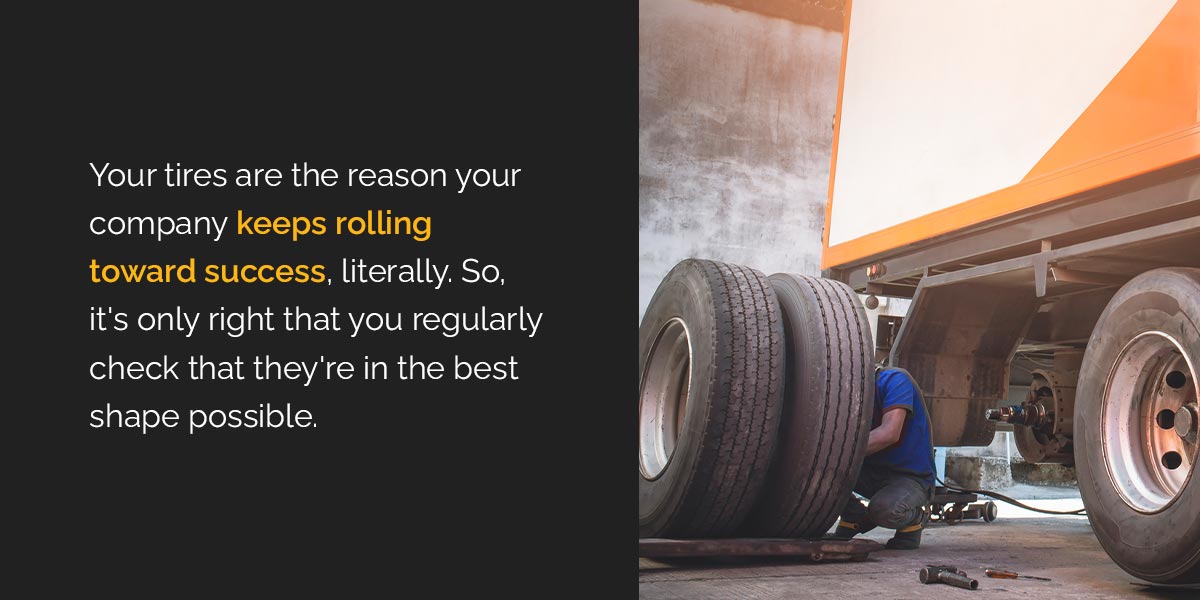
10. Take Care of Your Tires
Your tires are the reason your company keeps rolling toward success, literally. So, it’s only right that you regularly check that they’re in the best shape possible. For starters, make sure you regularly rotate tires, so tread-wear is even on all of them. Doing this will prolong the life of your tires and improve gas mileage. It’s also going to keep your truck’s alignment and suspension in check.
When you’re traveling long distances, you’re going to run into changing weather, which can affect your tire pressure. You should always monitor your fleet’s tire pressure to ensure they’re not under or overinflated. Under and overinflated tires can decrease fuel efficiency and lead to increased wear on your tires’ treads.
Overinflated tires are stiffer and less likely to mold around road hazards like rocks, cracks, or potholes. This rigidity could lead to damage to your tires, like a blowout. Underinflated tires make your vehicle more difficult to steer and can cause brake problems.
11. Understand Fuel Discounts
You deserve to know how fuel discounts and prices are calculated. That way, you know exactly what you’re paying and saving every time your drivers stop to refuel.
With a TCS Fuel Card, you can get these fuel discounts:
- Retail minus price: With retail minus price, your drivers can pay the retail price minus a negotiated discount for each gallon.
- Cost plus price: This means you’ll pay the price of a gallon of diesel, plus a pumping fee.
- Better of price: This discount means your drivers will pay the better of two prices between cost plus and retail minus when stopping at an in-network discount center.
12. Maintain Fuel-Conscious Habits
These are a few ways you can change your fleet’s driving habits to increase fuel efficiency:
- Utilize your momentum: Use your truck’s momentum to your advantage and lay off the gas pedal when rolling down hills. It’s counterproductive to accelerate down a hill when your heavy truck can roll on its own.
- Minimize AC use: If it’s a beautiful day and you need to cool off, roll down your windows rather than blasting the AC. Your AC uses fuel, but the wind from driving down the highway is all-natural.
- Consider when to get on the road: If you can, hit the road when traffic is at its lightest. This will minimize the number of times you’re potentially using fuel while at a standstill. Plus, aggressive accelerations and decelerations are going to eat up fuel more quickly.
- Be vigilant: If you’re in a high-traffic area, be vigilant about vehicles in front of and around you so you can anticipate when to slow down or stop.
Cut Down on Fuel Expenses With The TCS Fuel Card
Even if you don’t have a massive fleet, you still have plenty of responsibilities, including tracking fuel expenses. Today’s fuel prices are unpredictable, but with the TCS Fuel Card, you can carry on knowing you’re getting the best fuel prices and zero transaction fees at in-network fueling locations.
Just because your trucking company is small doesn’t mean you can’t save big at fuel pumps. Apply for a TCS Fuel Card today and start saving!
